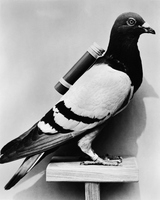In the history of mankind, in a world before advanced technology and rapid communication systems, animals have played remarkable roles beyond their natural habitats, serving as messengers and spies in times of war and peace. From pigeons and dogs to cats and even elephants, these creatures have been trained to deliver crucial messages across vast distances, often with astonishing speed and accuracy.
Pigeons, revered for their homing instincts and navigational abilities, were among the most widely used messengers throughout history. Trained since ancient times, these birds could cover long distances and return to their home roosts with remarkable precision, making them invaluable for military communication and civilian correspondence alike. During World War I and II, carrier pigeons were extensively utilized to relay messages between frontline troops and command posts, often braving enemy fire and adverse weather conditions to deliver critical intelligence.
Similarly, dogs have been employed as messengers for centuries, owing to their loyalty, obedience, and keen sense of smell. Trained messenger dogs were deployed by armies across various cultures, carrying important dispatches, medical supplies, and even lifesaving messages through treacherous terrain and enemy lines. These remarkable canines played a vital role in battlefield communication, helping to relay orders and coordinate troop movements with remarkable efficiency.
Cats, with their agility and stealth, were also utilized as messengers in certain historical contexts, particularly in ancient Egypt and during medieval times. While not as commonly employed as pigeons or dogs, cats were valued for their ability to navigate narrow passages and deliver messages discreetly, making them ideal for espionage and clandestine communication.
Beyond traditional domesticated animals, more exotic creatures like elephants have also been trained as messengers in certain cultures. In ancient India, for example, trained elephants were used to carry royal decrees and diplomatic missives across vast empires, traversing jungles, mountains, and rivers with ease. Their immense strength and endurance made them indispensable for long-distance communication in regions where other means were impractical or unavailable.
The criteria for selecting animals as messengers varied depending on the specific needs and circumstances of each situation. Generally, traits such as loyalty, intelligence, speed, and navigational skills were highly valued. Additionally, the ability to withstand harsh conditions and remain calm under pressure was essential for animals tasked with delivering messages in hostile environments or during times of conflict.
What truly sets these messenger animals apart is their remarkable intelligence and adaptability. Through careful training and conditioning, pigeons, dogs, and other creatures have demonstrated an astonishing capacity to learn and perform complex tasks, often surpassing human expectations. Their ability to interpret signals, follow commands, and navigate unfamiliar terrain with precision highlights the extraordinary bond between humans and animals forged through centuries of collaboration.
In conclusion, the use of animals as messengers throughout history speaks to the ingenuity and resourcefulness of humanity in leveraging the natural abilities of our fellow inhabitants on Earth. From pigeons soaring across battlefields to dogs racing through enemy lines, these remarkable creatures have played a vital role in shaping the course of human history, reminding us of the enduring partnership between humans and animals in the pursuit of shared goals and objectives.
